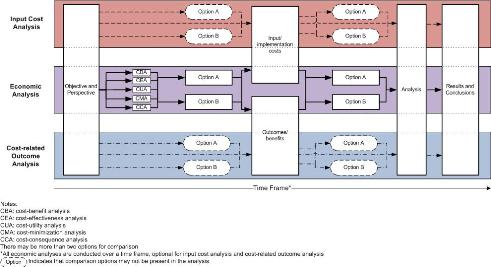Models
Economic Evaluation Types
As part of a review on economic evaluations of health information systems, the eHealth Observatory developed a diagram (see Figure 1) which summarizes the range of economic evaluations which can be undertaken and the components which should be present in each. It is based on previous work by Drummond[1] and Roberts[2].
Economic Analysis: The most comprehensive type of economic evaluation. This may be a cost-benefit analysis, cost-effectiveness analysis, cost-utility analysis, cost minimization analysis, or cost-consequence analysis. It must contain the following components:
- Objective or aim of the evaluation
- Perspective e.g. society, organizational or individual
- Time frame for analysis
- Alternative options for comparison e.g. pre-post implementation
- Input costs (measurable)
- Outcomes or benefits (measurable)
- Analysis which compares costs and outcomes for each option
- Results and conclusions
Input Cost Analysis: Focuses on examining the costs associated with development, implementation and maintenance of a system. These analyses may have a perspective, alternative options, time frame, and costs but are missing an analysis that links the costs to outcomes for each option.
Cost-related Outcome Analysis: Focuses on examining the outcomes associated with a system that have a cost component. These analyses may contain a perspective, alternative options, and time frame plus outcomes but are missing an analysis that links costs and outcomes for each option.
Figure 1: Economic Evaluation Types Diagram (click to enlarge)
[1] Roberts, M.S. (2006). Economic aspects of evaluation in C.P. Friedman & J.C. Wyatt Evaluation Methods in Biomedical Informatics: 301-337.
[2] Drummond, M.F. (2005). Methods for the economic evaluation of health care programmes. New York: Oxford University Press.

News and events
- Publications, presentations, and projects sections of website updated
- Paper published in International Journal of Health Information Management Research (2014)
- Paper published in BMC Medical Informatics and Decision Making (2014)
- Presented at Queen’s Health Policy Change Conference Series (May 15-16, 2014)
- Presented at CAHSPR 2014 Conference (May 12-14, 2014)
- Paper published in Healthcare Quarterly (2014)
- Paper published in Journal of American Medical Informatics Association (2014)
